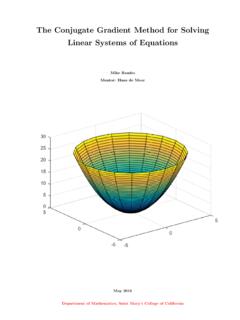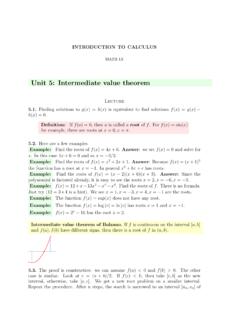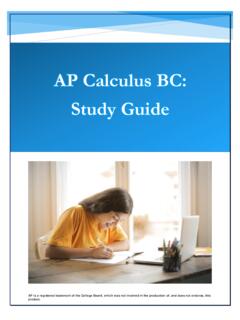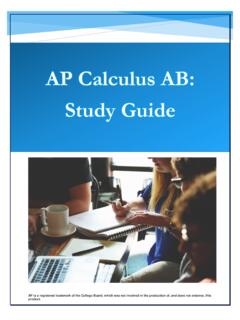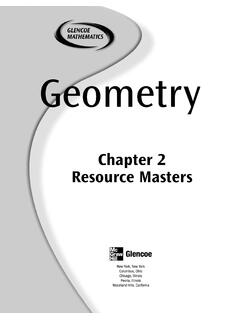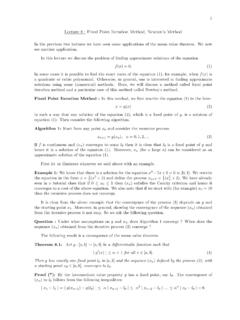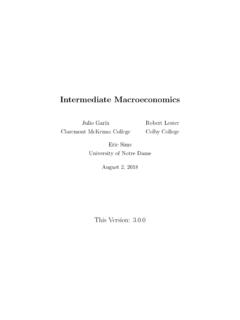Transcription of Brouwer Fixed-Point Theorem
1 Brouwer Fixed-Point TheoremColin BuxtonMentor: Kathy PorterMay 17, 201611 Introduction to Fixed PointsFixed points have many applications. One of their prime applications is in the math-ematical field of game theory; here, they are involved in finding equilibria. The existenceand location of the fixed point(s) is important in determining the location of any are then applied to some economics, and used to justify the existence of economicequilibriums in the market, as well as equilibria in dynamical systemsDefinition Fixed Point:For a functionf:X X, a fixed pointc Xis a pointwheref(c) = a function has a fixed point,c, the point (c,c) is on its graph.
2 The functionf(x) =xis composed entirely of fixed points, but it is largely unique in this respect. Manyother functions may not even have one fixed 1:f(x) =x, f(x) = 2, andf(x) = 1/x, respectively. The first is entirely fixedpoints, the second has one fixed point at 2, and the last has points came into mathematical focus in the late 19thcentury. The mathematicianHenri Poincar e began using them in topological analysis of nonlinear problems, moving Fixed-Point theory towards the front of topology. Luitzen Egbertus Jan Brouwer , of the Universityof Amsterdam, worked with algebraic topology. He formulated his Fixed-Point Theorem ,which was first published relating only to the three-dimensional case in 1909, though otherproofs for this specific case already 2: Henri Poincar e, left, and Luitzen Egbertus Jan Brouwer , , in 1910, presented his fixed point Theorem :1.
3 Brouwer Fixed-Point Theorem inR:Given that setK Rnis compact and convex,and that functionf:K Kis continuous, then there exists somec Ksuch thatf(c) =c;that is,cis a fixed original wording of Theorem gave this result forn-simplexes a specific class of com-pact and convex sets, ann-simplex is the simplest polygon inndimensions, that hasn+ 1vertices. However, here we will be focusing on unit intervals and discs General definitionsDefinition Topological SpaceA topological space is a set,X, equipped with ancollection of its subsets,T. The collection of subsets must includeXand the empty set . Itmust also be so that, for any arbitrary collectionU Tfor , the union U mustalso be part of the collectionT.
4 Finally, the intersection of any twoU1,U2 Tmust, again,be part ofT. Here,Tis called the topology ofX, and all members ofTare considered Open Set:In Euclidian metric spaceRn, the basic open sets are openintervals, discs, or balls forn= 1,2,3,..respectively. The full collection of open sets thetopology consists of the basic sets and their infinite unions and finite intersections. Thisalso includesRnitself and , the empty 3: Basic open sets inRandR2. Note that the interval is open, as the endpointsare not filled in, and that the disc has a dotted boundary, indicating that the points on theboundary are not actually in the Closed Set:A setF Rnis closed if its complement,FC, is open.
5 Aset is also closed if it is the arbitrary intersection or finite union of closed sets. InR, closedintervals and singletons are Convex:A setG Rnis said to be convex if, for any two pointsg1,g2 G, all points on the straight line segment connectingg1andg2are also 4: The left figure is convex, whereas the right is Open Cover:A collectionAof open sets inRnis an open cover for setAif the union of all sets inAhasAas a Compact:Let (X,T) be a topological space; if every open coveringAofAcontains a finite subcovering a finite subcollection ofAthat is still an open cover forA thenAis the most familiar of cases, the real numbers with the usual topology, a set must simplybe closed and bounded in order to be compact, as shown be the Heine-Borel Theorem .
6 Inparticular, this is true forRnwith the usual Continuous:Let (X,TX) and (Y,TY) be topological spaces. A functionf:X Yis continuous if, forVan open subset ofY, f 1(V) is open inX. The open setsinXandYare the member sets ofTXandTY, Open Map:Let (X,TX) and (Y,TY) be topological spaces. A functionf:X Yis an open map if, forUan open subset ofX, f(U) is open Bijection:A functionf:X Yis a bijection if it is injective andsurjective; that is to say,fis a bijection if for ally Ythere existsx Xsuch thatf(x) =y, and iff(x1) =f(x2) implies thatx1=x2. A function that is bijective will have awell-defined inverse; that is, its inverse will be a Homeomorphism:A homeomorphism is a function that is continuous,an open map, and bijective.
7 It is clear in this context, then, how being an open map relates toit having a continuous inverse, and how all of this relates to structures defined through opensets. The existence of a homeomorphism between two sets is sufficient to show that the twosets are homeomorphic. If two sets are homeomorphic, then they are topologically , topological properties that hold for one set will hold for any set homeomorphic to it infact, it is this quality that makes a property Case of 1 dimensionThe most simple case to consider the fixed point Theorem is when the setK RhasRonly having 1 dimension, and is in fact the unit square I= [0,1]. For a continuous5functionf: [0,1] [0,1] to have fixed points, it must be so that there is a pointc Xwheref(c) =c.
8 WhileKis one-dimensional, however, the actual work will be done in [0,1]2,which has two 5: The unit square; the unit interval crossed with itselfThis proof relies on the intermediate value Theorem : Theorem intermediate value Theorem :LetX,Y R. Given a functionf:X Ythat is continuous on [a,b] X, there exists for everyd (f(a),f(b)) Y(assuming,without loss of generality, thatf(a) f(b)) somec (a,b) such thatf(c) = 6: A pictoral representation of the intermediate value dealing with one dimension, any closed and convex subset ofRis homeomorphicto [0,1]. We can then show that any one-dimensional case for the Brouwer Fixed PointTheorem is equivalent to the case in [0,1], and thus, the Theorem applies Basic Proof of the Brouwer Fixed-Point Theorem on Set[0,1]Given that setKis compact and convex, and that functionf:K Kis continuous,then there exists somec Ksuch thatf(c) =c; that is,cis a fixed :Letf: [0,1] [0,1] be continuous function on the unit square.
9 The functiong(x) =f(x) xis also continuous on the unit square as well, as it is the difference of continuousfand the identity functioni(x) =xwhich is also continuous. Whenx= 0, f(0) 0,andg(0) =f(0) 0, sog(0) is either positive or 0. Now whenx= 1, f(1) 1, andg(1) =f(1) 1. Similarly,g(1) is either negative or a continuous function on a closed set, the intermediate value Theorem we haveg(0) 0 andg(1) 0, and it must be so that there is ac [0,1] suchthatg(c) =d, for anyd, but in particular whend= 0. Thus, we have a pointcwhereg(c) =f(c) c= 0; thus,f(c) =c, and thereforecis our fixed consider it through explanation, note a fixed point requires passing through the linef(x) =x.
10 Thus, a function without a fixed point cannot intersect this line. That, however,leaves something such as the figure below, which isn t 7: The darker function has no fixed point as it does not intersectf(x) =x(lighter),but it is absolutely not is impossible for a continuous function to not intersect the linei(x) =x; however, to7intersect that line is to have a fixed point, as all points oni(x) =xare in fact fixed (x) =f(x) x, instead of trying to not intersecti(x) =x, we are trying to notintersect the zero lineh(x) = 0. It is easier to show, using the intermediate value Theorem ,thatgintersects the constant functionhthat it is to show 8:f(x) = 2x2+ , left, andg(x) =f(x) x, Extension to Homeomorphic SetsIn order to determine whether a fixed point is guaranteed for some other compact convexintervalK, then one must determine whether or not a homeomorphism can be found betweenKand [0,1].


